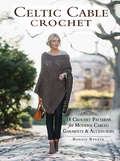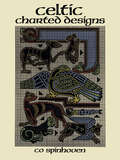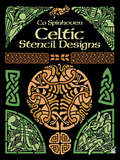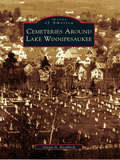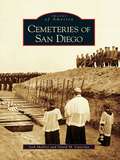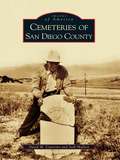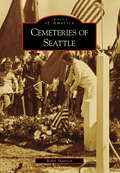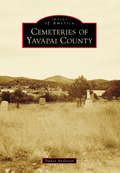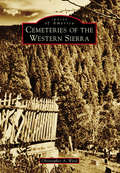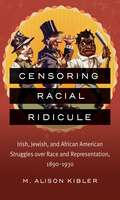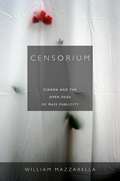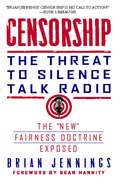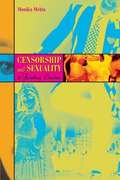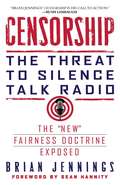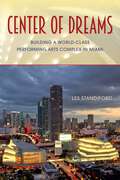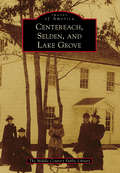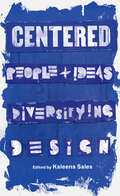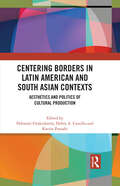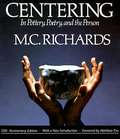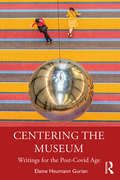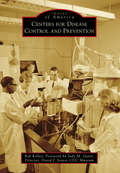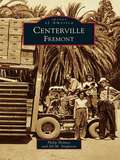- Table View
- List View
Celtic Cable Crochet: 18 Crochet Patterns for Modern Cabled Garments & Accessories
by Bonnie BarkerWarm up your wardrobe with beautiful cabled pieces! The possibilities of crochet cables are endless! In this stunning collection, author and fiber artist Bonnie Barker debuts 18 gorgeous new designs for today's crafter. Using step-by-step directions and irresistible photography, Bonnie shows you how to master this intricate technique to make: • Sophisticated sweaters, ponchos and shawls • Stylish hats, scarves, and gloves • A hip messenger bag with a contrasting fabric liner and a snappy shrug that's perfect for a night out with friendsCeltic Cable Crochet even includes a visual stitch dictionary that takes the guesswork out of each pattern. From start to finish, this all-in-one guide will get you hooked on crocheting contemporary, Celtic-inspired stitches.
Celtic Charted Designs
by Co SpinhovenSometimes referred to as "the work of angels" because of their elaborate spirals, interlacings, and knotwork, Celtic designs have long been used to create fine art. Their distinctive patterns have appeared on stone- and metalwork, in jewelry, and on magnificent illuminated manuscripts. Now the enduring beauty of this ancient are form is available in a collection specially designed for those who love to do embroidery and needlepoint. Dutch artist and designer Co Spinhoven has adapted over 300 unique designs -- with all their compelling strength, drama, and simplicity -- from the Book of Kells, the Tara Brooch, the Petrie Crown, and many other authentic Celtic sources. Divided into four basic sections, Celtic Charted Designs contains step, fret, and key patterns; spiral work, knotwork, and biomorphic patterns (designs with images resembling forms of living organisms). Patterns range from simple step motifs to ornate, highly stylized elements modeled after animal and plant life. Most designs are suitable for creating lovely needlepoint pillows, cross-stitch pictures, latch-hook rugs, knitted or crocheted garments, woven fabrics, and much more. An easy-to-follow text includes explanatory notes on designs, many of which are presented here for the first time in charted form. Here are patterns that will not only inspire needleworkers but will be welcomed by artists, craftspeople, and students of Celtic history and culture everywhere.
Celtic Realms: The History of the Celts from Pre-History to The Norman Conquest
by Nora Chadwick Myles DillonIn their masterly survey of the history and culture of the Celtic peoples, Dillon and Chadwick cover the whole period from the Celts' pre-historic origins to the Norman invasion of Britain. Though few really understand Celtic art, the authors demonstrate the peculiar genius of the Celts in their religion, literature, and visual arts.
Celtic Stencil Designs
by Co SpinhovenWith great skill and flair, Dutch artist Co Spinhoven has translated the stirring imagery of traditional Celtic art into a collection of 130 exciting and versatile stencil designs. With them, graphic artists and craftspeople can bring to their work the distinctive beauty and drama of a great decorative arts tradition. The designs, all copyright-free, are derived from the Book of Kells and other early medieval Celtic sources. Their themes range from birds and beasts of myth and scripture to elegantly wrought abstract motifs. The designs vary widely in size, shape, and complexity. They range from large and elaborate squares, circles, and rectangles to elongated border motifs to minimal design accents. Co Spinhoven has adapted each of them admirably to the technical requirements of stencil painting. Graphic artists, textile designers, and many others in the arts and crafts will find these sturdy, reusable stencils indispensable for adding - quickly and easily - authentic touches of Celtic imagery to their projects.
Cemeteries Around Lake Winnipesaukee (Images of America)
by Glenn A. KnoblockCemeteries Around Lake Winnipesaukee, a photographic study, reveals the compelling history of the region from the time when Native Americans first inhabited the lake's shore to the 1900s. These cemeteries are some of the oldest cultural and archaeological remnants of the past around the lake, and their scenic locations and gravestones and monuments provide a tangible link to the past. Through the author's collection of photographs, readers can see the final resting places of people as diverse as early settlers, ministers, doctors, Revolutionary and Civil War veterans, drowning victims, and even a controversial author. Readers will also discover the art and business of gravestone carving and learn about some of the region's early practitioners in this unusual art form.
Cemeteries of San Diego
by David M. Caterino Seth MalliosSan Diego has a rich and unique cultural history that can be effectively told through the commemoration of its dead. Local cemeteries throughout the city reflect San Diego's multiethnic cultural dynamism and pinpoint marked shifts in power from Native American to Spanish to Mexican to American governance. They also reveal the current struggle for space in a burgeoning metropolis. Graveyards, with their individually detailed and hauntingly beautiful monuments, offer an unrivaled historic yet continuous glimpse at the essence of this diverse community. The story of San Diego's cemeteries is a telling narrative that offers remarkable insight into the evolution of "America's Finest City."
Cemeteries of San Diego County
by Seth Mallios David CaterinoFrom its Native American and mission graveyards to its modern megacemeteries, San Diego County's historical landscape has an incredibly diverse array of final resting places. Cemeteries of San Diego County takes the reader in-depth to reveal the region's dynamic cultural history through dramatic modern photographs and never-before-seen vintage images of the county's most sacred spaces--its lost and forgotten historical burial grounds. A number of these graveyards have disappeared entirely, erasingthe last vestiges of too many of the region's formative pioneers. This book uncovers the location of dozens of local cemeteries and reestablishes them as consecrated grounds.
Cemeteries of Seattle
by Robin ShannonA fascinating story exists just below Seattle's surface, buried in the city's many historic cemeteries. Founded in 1872 on land acquired from Doc Maynard, Lake View Cemetery holds the remains of one of Seattle's favorite sons, Bruce Lee, whose son Brandon Lee is buried beside him. Maynard is also buried here, along with most of the Seattle pioneers, including the Dennys, Borens, Maynards, Yeslers, and Morans. Princess Angeline, Chief Sealth's daughter, was buried here in a canoe-shaped coffin, and Madame Damnable's remains supposedly turned to stone. Evergreen-Washelli Cemetery, founded in 1884 by the Denny family, contains Judge Thomas Burke, known as "the man who built Seattle"; a Veterans' Memorial Cemetery dating from the Civil War; and two cannons from the USS Constitution, famously nicknamed "Old Ironsides." Mount Pleasant Cemetery, founded in 1883 in Queen Anne, is the final resting place of the labor martyrs of the Everett Massacre and William Bell, of Belltown fame. Remembrance benches for Nirvana's Kurt Cobain and Jimi Hendrix's memorial are also local landmarks.
Cemeteries of Yavapai County
by Parker AndersonYavapai County, Arizona, is regarded as the most historically significant area within the state. After Arizona was proclaimed an American territory by Pres. Abraham Lincoln in 1863, it was here that the first territorial government was established. Yavapai County history and culture is reflected in its simple but deeply reverent burial grounds where many of Arizona's early pioneers are buried. The county has many cemeteries, and this book focuses on the most historic of these, from Prescott to Southern Yavapai ghost towns, where people ranging from Big Nose Kate to Sharlot M. Hall are interred, and examines the Old West's attitudes toward death and burial.
Cemeteries of the Western Sierra (Images of America)
by Christopher A. WardCemeteries are more than final resting places for the dead; they are gateways to an area�s shared history. Every hand-carved granite or marble monument, every faded wooden marker, holds a clue. Western Sierra populations boomed with the discovery of gold and often dwindled as gold fever waned. Cemeteries of the Western Sierra uses the lens of the cemetery to glimpse a rich and disappearing history. Displaced indigenous populations, miners, dueling newspaper magnates, Chinese pioneers: all are part of the mosaic of history represented in a historical cemetery. From solitary graves in the forest to almost forgotten graveyards near the center of a town, cemeteries tell a story not just of who may have died but also of who lived and what was meaningful in their time.
Censoring Racial Ridicule
by M. Alison KiblerA drunken Irish maid slips and falls. A greedy Jewish pawnbroker lures his female employee into prostitution. An African American man leers at a white woman. These and other, similar images appeared widely on stages and screens across America during the early twentieth century. In this provocative study, M. Alison Kibler uncovers, for the first time, powerful and concurrent campaigns by Irish, Jewish and African Americans against racial ridicule in popular culture at the turn of the twentieth century. Censoring Racial Ridicule explores how Irish, Jewish, and African American groups of the era resisted harmful representations in popular culture by lobbying behind the scenes, boycotting particular acts, and staging theater riots. Kibler demonstrates that these groups' tactics evolved and diverged over time, with some continuing to pursue street protest while others sought redress through new censorship laws. Exploring the relationship between free expression, democracy, and equality in America, Kibler shows that the Irish, Jewish, and African American campaigns against racial ridicule are at the roots of contemporary debates over hate speech.
Censorium: Cinema and the Open Edge of Mass Publicity
by William MazzarellaIn the world of globalized media, provocative images trigger culture wars between traditionalists and cosmopolitans, between censors and defenders of free expression. But are images censored because of what they mean, what they do, or what they might become? And must audiences be protected because of what they understand, what they feel, or what they might imagine? At the intersection of anthropology, media studies, and critical theory, Censorium is a pathbreaking analysis of Indian film censorship. The book encompasses two moments of moral panic: the consolidation of the cinema in the 1910s and 1920s, and the global avalanche of images unleashed by liberalization since the early 1990s. Exploring breaks and continuities in film censorship across colonial and postcolonial moments, William Mazzarella argues that the censors' obsessive focus on the unacceptable content of certain images and the unruly behavior of particular audiences displaces a problem that they constantly confront yet cannot directly acknowledge: the volatile relation between mass affect and collective meaning. Grounded in a close analysis of cinema regulation in the world's largest democracy, Censorium ultimately brings light to the elusive foundations of political and cultural sovereignty in mass-mediated societies.
Censorship
by Sean Hannity Brian JenningsFreedom of speech. It is our most cherished privilege as Americans, guaranteed by the First Amendment to the U.S. Constitution since 1791. But our current presidential administration threatens to sharply curtail or silence altogether the freedom of expression that distinguishes America from the average dictatorship. What is under direct attack? Conservative talk radio. During the Reagan administration, conservative talk radio burgeoned when the FCC voted to stop enforcing the Fairness Doctrine, which required all licensed broadcasters to present "balanced" viewpoints on controversial issues. The format was a smash hit, attracting an estimated 50 million listeners weekly. Popular, profitable, outspoken, powerful, influential--it's what the American people wanted, and its success was the Democrats' worst nightmare. Now, the principles underlying the Fairness Doctrine threaten to be reinstated. Under cover of being "fair," they will be used as a means of censorship, allowing government to influence who owns our airwaves and thus controls the content, a mandate with far-reaching implications for all media--indeed, for freedom of speech for all Americans.
Censorship and Sexuality in Bombay Cinema
by Monika MehtaIndia produces an impressive number of films each year in a variety of languages. Here, Monika Mehta breaks new ground by analyzing Hindi films and exploring the censorship of gender and heterosexuality in Bombay cinema. She studies how film censorship on various levels makes the female body and female sexuality pivotal in constructing national identity, not just through the films themselves but also through the heated debates that occur in newspapers and other periodicals. The standard claim is that the state dictates censorship and various prohibitions, but Mehta explores how relationships among the state, the film industry, and the public illuminate censorship's role in identity formation, while also examining how desire, profits, and corruption are generated through the act of censoring. Committed to extending a feminist critique of mass culture in the global south, Mehta situates the story of censorship in a broad social context and traces the intriguing ways in which the heated debates on sexuality in Bombay cinema actually produce the very forms of sexuality they claim to regulate. She imagines afresh the theoretical field of censorship by combining textual analysis, archival research, and qualitative fieldwork. Her analysis reveals how central concepts of film studies, such as stardom, spectacle, genre, and sound, are employed and (re)configured within the ambit of state censorship, thereby expanding the scope of their application and impact.
Censorship: The Threat to Silence Talk Radio
by Sean Hannity Brian Jennings"Talk radio is the American voter." -- Rush Limbaugh Freedom of speech. It is our most cherished privilege as Americans, guaranteed by the First Amendment to the U. S. Constitution since 1791. But at the dawn of a new presidential administration, an epic battle is looming -- a battle for our airwaves that could sharply curtail or silence altogether the freedom of expression that distinguishes America from the average dictatorship. The target of this battle is conservative talk radio. If key Democrats have their way, the principles of the Federal Communications Commission's Fairness Doctrine will once again be enforced and allow government to control the content heard on free radio, a mandate that will have far-reaching implications for all media. During the Reagan administration the FCC voted to stop enforcing the Fairness Doctrine, which required all licensed broadcasters to present "balanced" viewpoints on controversial issues. Conservative talk radio burgeoned, giving rise to the father of conservative talk, Rush Limbaugh, and such hosts as Sean Hannity, Mark Levin, Michael Medved, Neal Boortz, Laura Ingraham, and others. The format was a smash hit -- resonating with listeners from coast to coast and giving a powerful voice to the conservative movement. Soon such programming, attracting an estimated 50 million listeners weekly, dominated the airwaves where liberal talk radio failed. Popular, profitable, outspoken, powerful, influential -- it's what the American people wanted, and its success was the Democrats' worst nightmare. Now, the principles of the Fairness Doctrine threaten to be reinstated -- if not directly, then through back-door tactics involving ownership of stations. Under cover of being "fair," they will prove to be anything but: They will be used as a means of censorship by those with contempt for conservative talk radio. With our current Congress firmly under Democratic control, the future of talk radio -- indeed, freedom of speech for all Americans -- is under direct attack.
Center City Philadelphia
by Gus SpectorCenter City Philadelphia is a visual tour of the area's major thoroughfares, with a concentration on the legacy of its architecture and its historical importance in the growth and development of our nation. From the teeming frontage of Delaware Avenue to the bustling crowds on Market Street, from the wealthy mansions of Rittenhouse Square to the construction of the Benjamin Franklin Parkway, these vintage postcards provide elusive and seldom-seen views of Philadelphia during the first half of the 20th century, well before the present age of modern technology.
Center of Dreams: Building a World-Class Performing Arts Complex in Miami
by Les StandifordDiscover how one spectacular building project revolutionized Miami, how one man's moxie helped turn a fractious tropical city into a cultural capital of the Americas. In Center of Dreams, New York Times bestselling author Les Standiford tells the inspiring story of the Adrienne Arsht Center for the Performing Arts. The vision for this building, which would become the most ambitious cultural arts complex since the Kennedy Center, began in an unlikely place and time. Miami in the 1970s was divided by social and ethnic tensions. The city comprised a growing population of immigrants from the Cuban revolution, a well-established African American community, Florida "crackers," and a continual influx of tourists and retirees. Critics said a cultural center would never be possible in a place of such extreme diversity. But Parker Thomson, a lawyer and Boston transplant, knew his adopted city could become a world-leading community in the twenty-first century. He believed a performing arts center was critical to this vision. Everyone said his dream was impossible, he would never succeed, it couldn't be done. Not in Miami. But Thomson persevered against political opposition, economic roadblocks, and engineering problems. It took thirty years to overcome the odds and the obstacles, but he finally made the dream a reality. With Thomson's efforts, along with help from cultural leaders, iconic design work by architect Cesar Pelli, and support from philanthropist Adrienne Arsht, the center opened its doors in 2006 with a star-studded gala. Today the Arsht Center is a cutting-edge venue of style and art, a landmark beloved by the city's residents, and a magnet for tourists from all over the world. Presenting performances that celebrate the richness of Miami's diverse population, it showcases emerging local artists and attracts international stars. Resident companies include the New World Symphony, the Florida Grand Opera, and the Miami City Ballet. Its improbable story is a testament to the influence of cultural advocacy, the importance of government support for the arts, and the power of the arts to repair and sustain communities.
Centereach, Selden, and Lake Grove
by The Middle Country Public LibraryThe hamlets of Centereach, Selden, and Lake Grove are steeped in history. Revolutionary War captain Daniel Roe foiled British attacks on the area, saving lives by evacuating citizens via whaleboat to Connecticut. In 1818, the New Village Congregational Church was built in the small community. Over 200 years later, it still stands as a nationally recognized landmark. Albert Norton's Wheelmen's Rest on Bicycle Path refreshed weary cyclists during the cycling craze of the 1890s, when hundreds of miles of dedicated side paths were constructed for enthusiasts. Modern hero Clarence Dare, state district fire ranger, guaranteed safety from the heights of Bald Hill's lookout tower during the 1920s and beyond. Brookhaven police officer Alvin Smith patrolled from Smithtown to the Riverhead border to protect his neighbors in the 1930s. Together, the residents of these hamlets built and maintained schools and community organizations that nurtured and supported their vibrant, growing population.
Centered: People and Ideas Diversifying Design
by Kaleena SalesA rich, inclusive, contemporary, and global look at design diversity, past and present, through essays, interviews, and images curated by design educator and advocate Kaleena Sales.As the design industry reexamines its emphasis on Eurocentric ideologies and wrestles with its conventional practices, Centered advocates for highlighting and giving a voice to the people, places, methods, ideas, and beliefs that have been eclipsed or excluded by dominant design movements.Curated by Kaleena Sales, a powerful voice and noted advocate for diversity in the design community, the thirteen essays and interviews in this volume feature important and underrepresented design work and projects, both historical and present-day, including:Gee's Bend Quilters, by Stephen Child and Isabella D'AgnenicaA Chinese Typographic Archive, by YuJune Park and Caspar Lam Indigenous Sovereignty and Design: An Interview with Sadie Red Wing (Her Shawl is Yellow)The Truck Art of India, by Shantanu SumanNew Lessons from the Bauhaus: An Interview with Ellen Lupton Vocal Type: An Interview with Tré SealsDecolonizing Graphic Design, A Must, by Cheryl D. Miller And moreFilled with striking visuals from a range of global designers, Centered is a must-read and must-have for design practitioners, educators, students, and anyone interested in expanding narratives and gaining a more inclusive understanding of design diversity and its impact on culture.
Centering Borders in Latin American and South Asian Contexts: Aesthetics and Politics of Cultural Production
by Debaroti ChakrabortyThis book presents inter-disciplinary research on contemporary borders with contributions from scholars and cultural practitioners located in different contexts in the Americas and South Asia. There has been significant sociological work on borders; however there is a relative dearth of humanities research on contemporary border realities, particularly in South Asia. This volume introduces frameworks of critical insights and knowledge on border narratives and cultural productions. It addresses and goes beyond the impact of the partition in South Asia to train a unique comparative and aesthetic lens on borders and borderlands in relation to Latin America and the U.S.A. through oral narratives, photographs, ‘objects’, films, theatre, journals, and songs. It maps border perspectives and their reception in a framework of cultural politics. It revolves around themes such as violence and modes of survival; women’s narratives of migration, trafficking and incarceration; abduction of children; vulnerability as experience; rationalities of mass killings; and proliferation of countercultures to map border perspectives in a framework of cultural politics. First of its kind, the volume will be useful to scholars and researchers of comparative literary and cultural studies, South Asian studies, Latin American studies, border studies, arts and aesthetics, visual studies, sociology, comparative politics, international relations, and peace and conflict resolution studies.
Centering in Pottery, Poetry, and the Person (2nd edition)
by Mary Caroline RichardsA discussion of how to balance life through use of pottery, poetry and education. The book uses examples of the author's poetry.
Centering the Museum: Writings for the Post-Covid Age
by Elaine Heumann GurianDrawing on Elaine Heumann Gurian’s fifty years of museum experience, Centering the Museum calls on the profession to help visitors experience their shared humanity and find social uses for public buildings, in order to make museums more central and useful to everyone in difficult times. Following the same format as Civilizing the Museum, this new volume includes material written especially for a re-emergent time and relevant public lectures not included in the author’s previous book. Divided into six separate content clusters, with over twenty different essays, the book identifies many small, subtle ways museums can become welcoming to more—and to all. Drawing on her extensive experience as a deputy director, senior advisor to high-profile government museums, lecturer and teacher around the world, the author provides recommendations for inclusive actions by intertwining sociological thinking with practical decision-making strategies. Writing reflectively, Elaine also provides heritage students and professionals with insights that will help move their careers and organizations into more equitable, yet successful, terrain. Centering the Museum will be an excellent companion volume to Civilizing the Museum and, as such, will be a useful support for emerging museum leaders. It will be especially interesting to academics and students engaged in the study of cultural administration, as well as museum and heritage practitioners working around the world.
Centers for Disease Control and Prevention
by Bob Kelley Judy GanttFor over 60 years, the Centers for Disease Control and Prevention has worked tirelessly to address infectious diseases and other health hazards. Through the vision of Dr. Joseph W. Mountin, the Communicable Disease Center was created in 1946 as the successor to Malaria Control in War Areas (MCWA), a division of the Public Health Service based in Atlanta. The new agency, CDC, was charged with monitoring and controlling malaria, typhus, and other infectious diseases nationwide. Successful in addressing a wide array of health emergencies--including polio, measles, influenza, Legionnaires' disease, toxic shock syndrome, and the Ebola virus--one of the CDC's crowning achievements was its role in the global eradication of smallpox. Known today as the Centers for Disease Control and Prevention, it is recognized as the nation's premier health promotion, prevention, and preparedness agency and a global leader in public health. Discover how a bad batch of polio vaccine brought a nationwide immunization campaign to a standstill, how the mysterious Legionnaires' disease sparked nationwide panic and how, today, CDC scientists are at the forefront of prevention research.
Centerville, Fremont
by Philip Holmes Jill M. SingletonThe tale of Centerville, Fremont--part of the sprawling landscape of the southeast San Francisco Bay--begins with near forgotten histories such as the once sprawling grandeur of the Alviso rancho and the California 100, a battalion raised in Centerville for the Civil War. Centerville celebrates a sporting-mad past, centrally located on the "Way to San Jose" from Oakland on the long, straight stretch once famed for horse and then bicycle racing and later as a motor-touring destination on the early Route 17. By the 1890s, Centerville was home to Washington Union High School and the Centerville Athletic Club and began collecting trophies in football, rugby, baseball, and other sports. Fabled athletes of later eras include Wimbledon tennis queen Helen Wills Moody, football coach Bill Walsh, and hall of fame pitcher Dennis Eckersley.
Centinaia di opportunità per fare soldi
by Stefano Vazzola Bernard LevineQuesto libro eccezionale vi insegnerà diversi modi di fare soldi. Se volete ottenere un secondo secondo stipendio... Se volete ricevere più soldi sul vostro conto corrente ogni mese... Allora questo libro è la risposta. Ci sono moltissimi modi per guadagnare soldi nel tempo libero facendo ciò in cui siete bravi e ciò che amate. Ce n'è per tutti! Molte di queste opportunità legittime di guadagno vi consentiranno di mettervi in tasca dei soldi senza dover mettere piede fuori di casa. Per avere un flusso di denaro costante nella vostra vita, dovete avere le competenze e le conoscenze del caso rispetto a ciò che dovete fare perché si avveri. Dovete conoscere i nomi delle aziende che vi pagheranno. Dovete avere diverse fonti costanti di reddito che vengono versate sul vostro conto bancario. E c'è più di un modo di fare soldi. Il segreto del successo sta in ciò che riuscite a realizzare per voi stessi. Vi manca pochissimo per iniziare e imboccare la via per ottenere denaro versato regolarmente sul vostro conto bancario. Cosa state aspettando? Questo libro eccezionale vi mostrerà centinaia di modi e idee diversi per ottenere un flusso costante di reddito aggiuntivo! Scegliete l'opzione che vi piace di più e iniziate a guadagnare!
